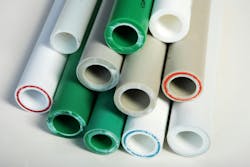Picking Plastic for Pipe
About the author: Amanda Fisher, CWS-VI, is product certification supervisor for the Water Quality Assn. Fisher can be reached at [email protected] or 630.505.0160.
When choosing pipe or fittings for any water application, the material options can be overwhelming. This was not always the case, though: For centuries, most pipe was made of lead or wood. In fact, the word plumbing is derived from the Latin word for lead, plumbum. Although the mechanical properties of lead are advantageous for making pipe, its toxicity is an issue. Wood pipe, on the other hand, is nontoxic, but susceptible to leaks. And because wood is soft, people could easily drill into the pipe and steal water.
Non-lead metal pipe (usually in the form of cast iron, ductile iron, steel or copper) eventually replaced the use of lead and wood. In the 1930s, plastic pipe was introduced to the market, and by the 1970s many homes were being equipped with it.
Today, a seemingly endless amount of metal and plastic pipe materials are available. To make matters more confusing, no two people can agree on which type of pipe is best. Because each material has strengths and weaknesses, it is important to take the following things into consideration when selecting one: strength, life/durability, transportation expense, jointing process, maintenance and application. Below are descriptions, including strengths and weaknesses, of five common types of plastic pipe.
ABS Pipe
Acrylonitrile butadiene styrene (ABS) pipe was the first residential plastic pipe to appear on the market. It is made from a thermoplastic resin and comes in a wide variety of sizes. It can be used above or below ground, but is best suited for drain, waste and vent applications. ABS typically has a 50-year lifespan.
One of the main advantages of ABS pipe is that it can be connected with a quick one-step gluing process. The pipe does not work well in hot-temperature applications (more than 160°F), and can deform in the sun. When used outdoors, some local regulations require ABS pipe to be painted with a water-based latex paint or to contain special pigments that prevent ultraviolet (UV) light from penetrating it.
PVC Pipe
Polyvinyl chloride (PVC) pipe is made from a thermoplastic resin that is less flexible than the resin used to make ABS pipe, and comes in a wide variety of sizes. It is typically used in drain, waste, vent and cold drinking water applications. It is strong, durable, rigid, corrosion resistant and somewhat chemically resistant. It has an expected lifespan of 50 to 100 years.
Joining PVC pipe requires a slower two-step process using primer and glue, making it more cumbersome to connect than ABS; however, PVC is generally affordable, safe and easy to install. It does not work well in extremely cold- or hot-temperature applications (more than 140°F). If burned, it releases a harmful gas.
CPVC Pipe
Chlorinated polyvinyl chloride (CPVC) pipe is similar to PVC pipe, but can be used in more diverse applications. It is stronger, thinner and more flexible than PVC pipe, and therefore can be used in more complex plumbing systems. It can handle both hot and cold water temperatures.
Typically, CPVC is used in water supply and distribution lines. Like other plastic pipe, it is easy to repair. The main disadvantage of CPVC is that it is subject to cracking and expanding and becomes brittle over time. It has an expected lifespan of 30 to 50 years.
PEX Pipe
Cross-linked polyethylene (PEX) pipe is manufactured from high-density polyethylene with cross-linked polymer bonds. The cross-linking makes it stronger and more durable than other plastics, like CPVC. PEX is typically available only in smaller sizes (1/4 to 4 in.). The tubing comes in spools, and therefore is easy to transport. It is flexible, simple to cut and can be installed quickly using compression fittings.
PEX is generally cheaper and less labor intensive than CPVC pipe. Its main disadvantage is that it degrades rapidly in sunlight. It has an expected lifespan of 30 to 50 years.
PE Pipe
Polyethylene (PE) pipe is used in both potable water and wastewater applications. It comes in a wide variety of sizes. The smaller sizes are typically sold in coils, while the larger sizes are typically sold in straight lengths. PE is flexible, durable, abrasion resistant, corrosion resistant and has high impact resistance.
PE is not resistant to some chemicals (oxidizing acids, ketones or chlorinated hydrocarbons) and can degrade in the presence of UV light. The pipe is joined using a heat fusion process, which requires special equipment. This connection method, however, can significantly reduce the chance of leaks over the lifetime of the pipe. PE pipe has an expected lifespan of 50 to 100 years.
The above are just five common types of plastic pipe materials. There are a number of other materials available on the market, including polyvinylidene difluoride, polybutylene, polypropylene, molecularly oriented polyvinyl chloride and composite materials, in addition to the more traditional metal options (ductile iron, copper and stainless steel). It is important to research material options and take into consideration the intended application, budget and resources available for installation and maintenance when choosing a pipe material.
Download: Here
